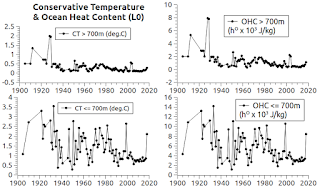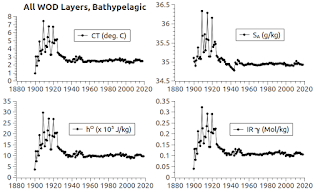 |
| The blue squares mark the 6 WOD Layers in the World Ocean Database used today |
I. Specifically Speaking
Today, let's get specific on some of the problems related to the impact of global warming on the ocean.
I am reminded of the words required when completeness in research is the goal (e.g. who, what, when, where, why, and how).
I say that because many of the peer reviewed scientific papers, together with too many writers in the warming commentariat media, are not being specific enough, IMO, about some specific oceanography subjects (The Warming Science Commentariat, 2, 3, 4, 5, 6, 7, 8, 9, 10, 11, 12, 13).
 |
| All Layers (c. 1900-2018) |
 |
| All Layers (c. 1960-2018) |
 |
| Layer 0 (c. 1900-2018) |
 |
| Layer 0 (c. 1960-2018) |
 |
| Layer 1 (c. 1900-2018) |
 |
| Layer 1 (c. 1960-2018) |
 |
| Layer 8 (c. 1900-2018) |
 |
| Layer 8 (c. 1960-2018) |
 |
| Layer 9 (c. 1900-2018) |
 |
| Layer 9 (c. 1960-2018) |
 |
| Layer 15 (c. 1900-2018) |
 |
| Layer 15 (c. 1960-2018) |
 |
| Layer 16 (c. 1900-2018) |
 |
| Layer 16 (c. 1960-2018) |
As an example notice the following piece from Nature Climate Change, volume 6, page 394 (2016):
"Formal detection and attribution studies have used observations and climate models to identify an anthropogenic warming signature in the upper (0–700 m) ocean. Recently, as a result of the so-called surface warming hiatus, there has been considerable interest in global ocean heat content (OHC) changes in the deeper ocean, including natural and anthropogenically forced changes identified in observational, modelling and data re-analysis studies. Here, we examine OHC changes in the context of the Earth’s global energy budget since early in the industrial era (circa 1865–2015) for a range of depths. We rely on OHC change estimates from a diverse collection of measurement systems including data from the nineteenth-century Challenger expedition, a multi-decadal record of ship-based in situ mostly upper-ocean measurements, the more recent near-global Argo floats profiling to intermediate (2,000 m) depths, and full-depth repeated transoceanic sections. We show that the multi-model mean constructed from the current generation of historically forced climate models is consistent with the OHC changes from this diverse collection of observational systems. Our model-based analysis suggests that nearly half of the industrial-era increases in global OHC have occurred in recent decades, with over a third of the accumulated heat occurring below 700 m and steadily rising."(Industrial-era global ocean heat uptake doubles in recent decades, emphasis added; cf. here). Ok, so some team writes some software which tells the computer(s) being used how to tell everyone about OHC from top to bottom.
In other words, evidently the model induced them to conclude that "nearly half" of "OHC" has taken place in "recent decades" with "over a third" of all that ending up in seawater deeper than 700 m.
The words "nearly, recent, over, and deeper" are not exact enough for strict scientific conclusions IMO.
II. What is OHC?
Further, they pointed out that the meaning of "OHC", in English, is "Ocean Heat Content."
However, that too is insufficient because they do not tell us what they think the meaning of OHC is in scientific terms (it was a scientific paper wasn't it?).
An expert of experts has told them (them = "Industrial-era global ocean heat uptake" authors) and the rest of us exactly what "OHC" is in scientific terms that models have not yet been introduced to:
"Potential temperature is used in oceanography as though it is a conservative variable like salinity; however, turbulent mixing processes conserve enthalpy and usually destroy potential temperature. This negative production of potential temperature is similar in magnitude to the well-known production of entropy that always occurs during mixing processes. Here it is shown that potential enthalpy—the enthalpy that a water parcel would have if raised adiabatically and without exchange of salt to the sea surface—is more conservative than potential temperature by two orders of magnitude. Furthermore, it is shown that a flux of potential enthalpy can be called “the heat flux” even though potential enthalpy is undefined up to a linear function of salinity. The exchange of heat across the sea surface is identically the flux of potential enthalpy. This same flux is not proportional to the flux of potential temperature because of variations in heat capacity of up to 5%. The geothermal heat flux across the ocean floor is also approximately the flux of potential enthalpy with an error of no more that 0.15%. These results prove that potential enthalpy is the quantity whose advection and diffusion is equivalent to advection and diffusion of “heat” in the ocean. That is, it is proven that to very high accuracy, the first law of thermodynamics in the ocean is the conservation equation of potential enthalpy. It is shown that potential enthalpy is to be preferred over the Bernoulli function. A new temperature variable called “conservative temperature” is advanced that is simply proportional to potential enthalpy. It is shown that present ocean models contain typical errors of 0.1°C and maximum errors of 1.4°C in their temperature because of the neglect of the nonconservative production of potential temperature ... and potential temperature, rests on an incorrect theoretical foundation ..."(Potential Enthalpy: A Conservative Oceanic Variable for Evaluating Heat Content and Heat Fluxes, emphasis added). Dr. McDougall informed us of this scientific reality about 16 years ago (2003).
The algorithms were incorporated into the official software (TEOS-10) for oceanography in 2010, some six years before the first article quoted ("Industrial-era global ocean heat uptake") was written.
That article does not mention TEOS-10 or the World Ocean Database (WOD) as it seems to complain about a lack of data:
"We rely on OHC change estimates from a diverse collection of measurement systems including data from the nineteenth-century Challenger expedition, a multi-decadal record of ship-based in situ mostly upper-ocean measurements, the more recent near-global Argo floats profiling to intermediate (2,000 m) depths, and full-depth repeated transoceanic sections."(ibid). They didn't need no stinkin WOD, SOCCOM, OMG or WHOI data.
Hence their "model-based analysis suggests" their conclusions.
III. Clues in The Datasets
The data used to produce today's graphs are from the usual sources:
The WOD datasets used are APB, CTD, DRB, GLD, MRB, OSD, PFL, and UOR, but the XBT, MBT and surface-only datasets are excluded.(Patterns: Conservative Temperature & Potential Enthalpy - 3). The in situ measurements in those datasets are loaded from an SQL server then processed into CSV format files.
Some non-WOD datasets are also used (NASA OMG for Greenland, SOCCOM for Antarctica, and Woods Hole Institute for Arctic ocean areas).
In short, billions of records are used to generate the CSV files and subsequent graphs.
IV. Clues In The Graphs
Those CSV files are converted into graphs by the Scientific Data Analysis and Visualization program (SciDAVis).
The graphs in today's post do not support what the "Industrial-era global ocean heat uptake" paper tells us, or what their model "suggests" to those authors.
Unless we "interpret" it.
With that in mind, I took a clue from the SOCCOM team:
"The vast Southern Ocean, which surrounds Antarctica, plays a starring role in the future of climate change. The global oceans together absorb over 90 percent of the excess heat in the climate system and roughly three-quarters of that heat uptake occurs in the Southern Ocean. In addition, the global oceans absorb around 25 percent of anthropogenic carbon dioxide emissions and the Southern Ocean alone accounts for about half of the uptake of CO2.(Climate Central). If that is true, the clue is to look in the Southern Ocean where the OHC uptake should be more easily found.
Despite its critical role in our climate system, the Southern Ocean has gone almost completely unobserved. Scientists have struggled to gather precise measurements because of the harsh environment and extreme remoteness. The changing dynamics of the Southern Ocean will in turn drive key aspects of our future climate, including how sensitive the Earth will be to further warming and increases in carbon dioxide emissions. As a result, improved observations are crucial to helping scientists understand and predict how our climate will change."
Today's graphs are: two from the Arctic Ocean area (Layers 0, 1), two from the Equatorial area (Layers 8,9), and two from the Southern Ocean (Layers 15, 16).
The graphs of the Southern Ocean (Layers 15 and 16) show a sharp uptake of OHC (a.k.a. "Potential Enthalpy", a.k.a. hO) indicating the veracity of the SOCCOM statement ("The global oceans together absorb over 90 percent of the excess heat in the climate system and roughly three-quarters of that heat uptake occurs [ends up] in the Southern Ocean").
V. Clues From The Ice Melt
Where does the OHC go after arriving in the Southern Ocean at Antarctica?
Well, the great current brings in OHC, which melts tidewater glacier ice, which neutralizes the hO (i.e. it disappears from the screens of suggestive models).
Then the current takes the resulting cold melt water away, and brings in new water with more hO in it (hungry to eat some more tidewater glaciers).
The great Antarctic current circling the ice continent (The Antarctic Circumpolar Current or ACC) is a regular ice melting machine (Mysterious Zones of Antarctica).
(I think I will begin to try to calculate how much neutralization of OHC is done by the melting of the tidewater glaciers, so stay tuned).
But finally, the OHC that entered the ice becomes sea level change (SLC) as shown in many Dredd Blog series (Countries With Sea Level Change; NASA Busts The Ghost; The Ghost Plumes, 2, 3, 4, 5, 6, 7).
VI. Closing Comments
It would be nice if the researchers would jump into "the world according to measurements" with both feet.
The bottom line is that OHC works its way down into the ocean deeps, then is transported to the Southern Ocean where it gives up its photons (The Ghost Photons, 2, 3) to melt the subsurface glacial ice, then it returns to the great Antarctica current to be reborn.
The previous post in this series is here.










